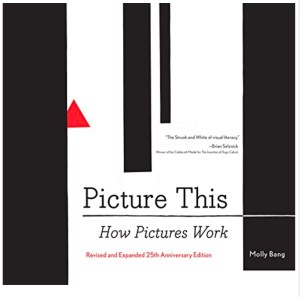
“Design is as much an act of spacing as an act of marking.” – Ellen Lupton, Senior Curator of Contemporary Design at Cooper Hewitt, Smithsonian Design Museum
After Basic Picture Arranging Principles, the seventh tutorial of the Graphic Design Basic Element Series covers Five Basic Relationships.
Ellen Lepton’s, quote is a perfect statement to describe the esthetics of an art piece that is marked using a thoughtful relationship between the objects within the intended presentation.
When the subjects are too crowded, or the symmetry and balance lack planning, the art piece message may get lost in the design. A rendering or painting where design elements interact to support the theme will convey a pleasing story. The viewer may never know why they appreciate the art while feeling the statement captured the artist’s intent.
Referral

When two edges of an objects in the illustration are aligned parallel to each other but not touching the descriptive term is Referral in design.
An obvious architectural example is city buildings with a very small clearance between the structures.
This is often the case when taking a snapshot of a row of buildings from a street view.
Point to Point/Point to Edge

Two other relationships occur when round or triangular shapes are rendered.
An example is a round ball that butts up to a box. When looking closely only a very small point on the edge of the ball actually touches the wall. This is called point to edge.
Point-to point occurs when you place any apex of an angled shape, such as a triangle next to either a linear edge or a circular object. Only the apex touches the edge.
Overlapping

Another relationship is overlap, so overlapping is the third relationship.
Imagine a fence along a sidewalk. A gardener plants a row of flowers and even though the floral border doesn’t touch the background fencing, in a rendering the viewer perceives the rendering of the flora and fauna as overlapping.
The gardener may have placed a fountain in the scene next to the fence. Again, the fountain will appear as an overlap. In essence, overlap is a visual relationship. Contrasting elements are visually noticed.
Negative/Positive Removal

In a previous tutorial describing Basic Surface Enrichments, the qualities that create a pattern were described.
Design patterns are created using any surface enrichment or combinations. Negative/positive qualities were first introduced along with an example in this tutorial.
In a Negative/positive Removal an actual shape is popped out of another shape. Then the removal is placed elsewhere in the visual story. The pop out might could be placed next to the initial shape and depending on the removal’s shape it could also have a relationship of either Referral, Point to Point, or Point to Edge!
Referral of Edge Alignments
In this last of the five relationships, a continuous flow of edges combine together to make an inclusive statement. A great example is a block of varied size posters placed on a wall together. Another might be many paintings placed to appear as a unified grouping telling a story.
Art Play
An enjoyable and rewarding art exercise is noticing the relationship between objects while taking a walk; take time and photograph several of each of the 5 Basic Relationships. You can also learn more about art and design by noticing your emotional response to the images as you review your photos later.
Supportive Art Resources
 Picture This, How Pictures Work is a wonderful resource to provide a helpful understanding of the most basic creative principles. Anyone can gain an understanding of how to build powerful pictures.
Picture This, How Pictures Work is a wonderful resource to provide a helpful understanding of the most basic creative principles. Anyone can gain an understanding of how to build powerful pictures.
Picture This is used by art and graphic departments in colleges around the country.
Learning how pictures work to create emotional engagement gives an artist more creative power in telling a story with their art images.
Downloadable Tutorial Guide
Our next tutorial will describe the Five Basic Removals found in design and a downloadable tutorial image.
To follow along, click > Art & Design Tutorial Table of Contents


All of these are very interesting! Thanks again!